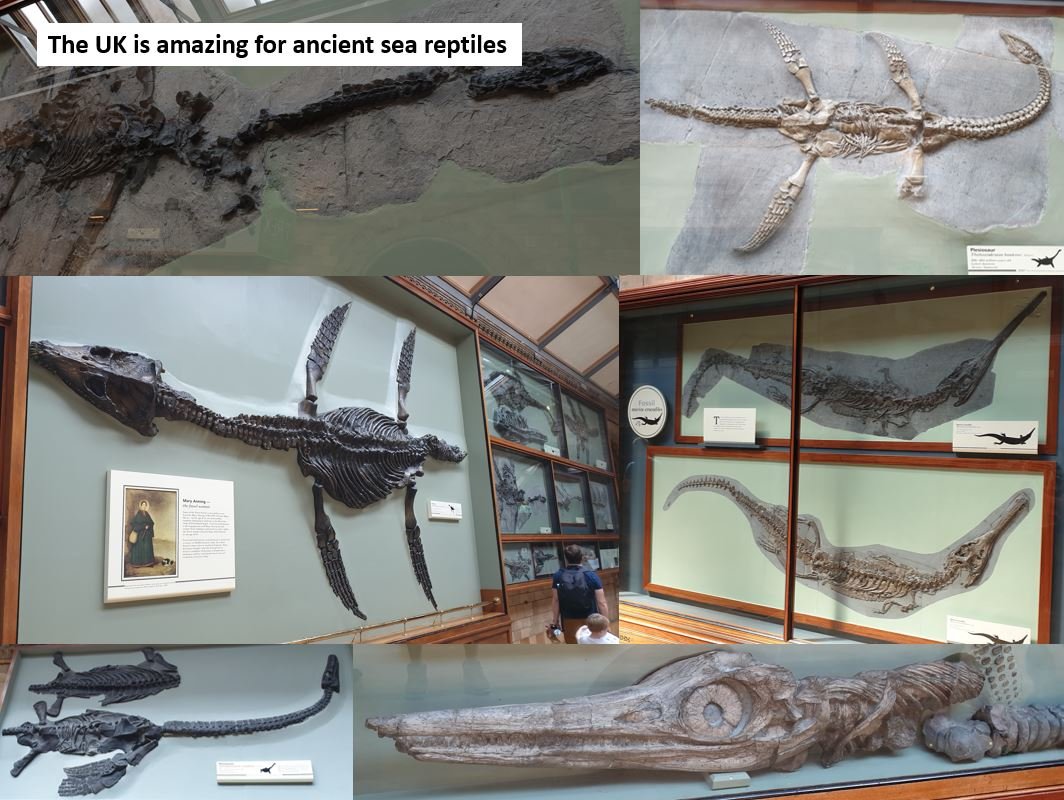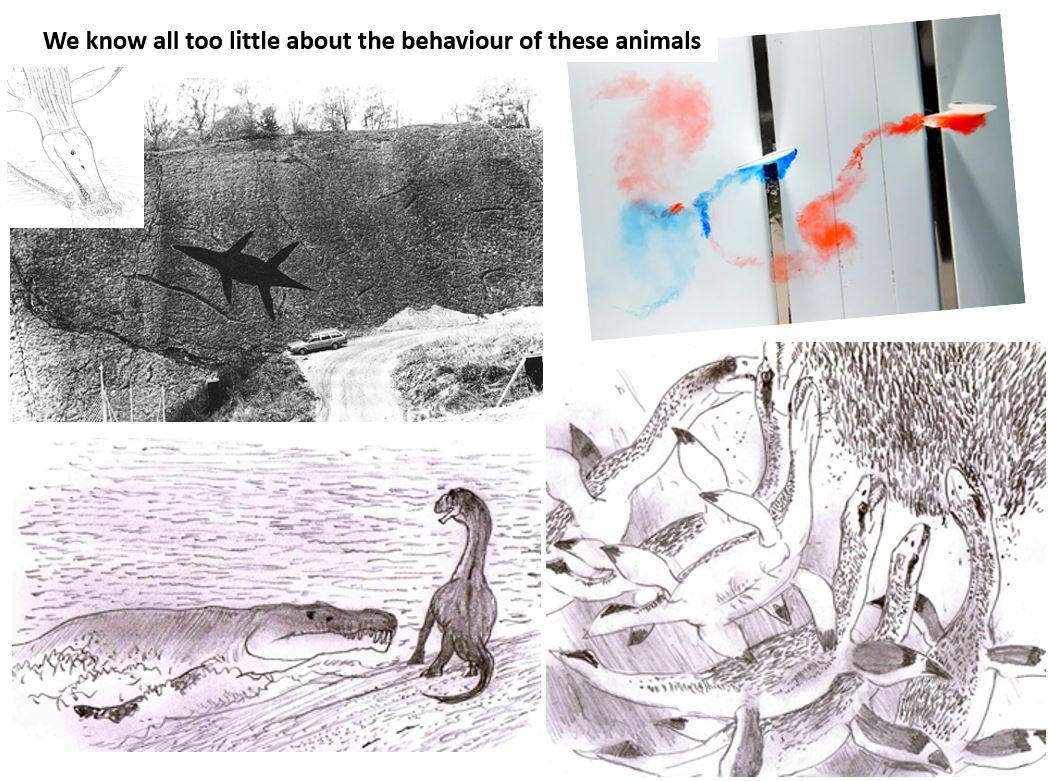Regular readers will be aware that my latest book – Ancient Sea Reptiles (Natural History Museum Publishing in the UK, Smithsonian Books in the US) – is now out and on sale…
Massive thanks to those who’ve bought the book and shared images or thoughts on it. A consequence of the book’s newness is that I’ve been giving talks on it, most recently at the Lyme Regis Fossil Festival in late April. I love going to Lyme Regis, and the talk went alright I think (space was very limited, so quite a few people unfortunately had to be turned away). In this brief article, I thought I’d share a few of the slides from the talk, and accompany them with a bit of extra information.
Caption: scenes from the Lyme Regis Fossil Festival 2023.
The many diverse groups. Ancient Sea Reptiles devotes appropriate space to the five ‘main’ marine reptile groups of the Mesozoic: the ichthyosaurs or fish-lizards, the mostly long-necked plesiosaurs, the thalattosuchians or ‘sea crocs’ (which are not crocodiles at all, hence my use of the informal ‘crocs’), those great sea-lizards the mosasaurs, and the sea turtles. There’s a lot to say about all of these groups (Naish 2023).
However, there are numerous other relevant groups as well, and I did my best to give them fair coverage too. Many of these were alive during the Triassic, including the long-tailed thalattosaurs, the very peculiar hupehsuchians, the (mostly) shellfish-eating placodonts, the fang-toothed helveticosaurs, the nothosaurs, the pistosaurs, and so on. Shared anatomical traits show that some of these groups are close cousins of plesiosaurs and belong with them in a large group termed Sauropterygia; hupehsuchians appear to be close kin of ichthyosaurs (Motani 1999, Motani et al. 2015). Entirely different groups whose affinities lie elsewhere evolved during the Jurassic and Cretaceous, including the marine pachyophiid snakes.
Finally, it’s becoming increasingly inaccurate to refer to these animals collectively as ‘Mesozoic marine reptiles’, given that there are several relevant groups from the Permian (the age before the Mesozoic), and evidence that some of the famous ‘Mesozoic’ groups – I’m thinking here of ichthyosaurs – actually originated during Permian times (Kear et al. 2023).
Caption: map of the world during Early Jurassic times, with a focus on far Western Tethys and flooded Europe. The Viking Corridor connected this region to the Boreal Ocean/Sea in the north, and the Hispanic Corridor connected it to Panthalassa in the west. Image: Naish (2023), after Korte et al. 2015.
A stereotype that’s still perpetuated is that the Mesozoic was monotonously hot, stable, and hence perfect for reptile evolution and perpetuation. It’s true that parts of the Mesozoic were hot and stable. But it’s absolutely not right to think that this was true of the whole of Mesozoic time. Geological and isotopic data shows that temperate (O’Brien et al. 2017, Alberti et al. 2019), cool and even cold conditions were present during parts of the Jurassic and Cretaceous; in fact, sea surface temperatures were close to freezing during parts of the Early Jurassic (Korte et al. 2015). Marine reptile groups like plesiosaurs and ichthyosaurs were swimming in these seas. The fossil record also shows that plesiosaurs, ichthyosaurs and mosasaurs were in polar waters at times when these regions were cool and seasonally dark. Some of these animals were insulated by blubber and it seems that endothermy was present in all of the main groups (Motani 2005, 2010, Martineau et al. 2010, Harrell et al. 2016, Wintrich et al. 2017, Fleischle et al. 2018).
Their world was also geographically and tectonically complex, with active volcanic regions, narrow marine corridors, and semi-enclosed seas. During the Jurassic, the marine faunas of western Europe were connected via the Viking Corridor to the Boreal Ocean (also called the Boreal Sea or Arctic Sea) in the far north, and via the Hispanic Corridor or Caribbean Seaway in the west to the great ocean Panthalassa. Marine reptiles thrived in all of these places and the presence of related species shows that groups moved around via these various seaways. However, the exact timings and directions of their movements remain enigmatic and several possibilities exist.
On Eurocentricism. Those of us living in western Europe are in an ideal location when it comes to fossil marine reptiles: there are a great number of significant fossil-bearing sites from which an extraordinary number of spectacular fossils have been extracted. The montage above shows specimens on show in the spectacular palaeontology corridor at the Natural History Museum in London, and all the specimens you see here are British. Germany, France, Luxembourg and other western European countries also have excellent marine reptile fossils.
A consequence of this fact is that our views on these animals – I’m mostly talking here about Jurassic groups – tend to be highly Eurocentric. Today, we know that animals similar to those of Europe occurred around South America, in the Caribbean, on the western coast of North America, and elsewhere too, so the view that these animals originated in Europe or should be considered strongly associated with Europe could well be very wrong.
Much work remains to be done and it’s hoped that new discoveries will improve our understanding of how these animals were distributed and how they moved about across their histories. It does, however, remain the case that a great many groups are essentially known from Europe and nowhere else. We assume that this is an artifact of the geological record and the history of scientific collecting, but bring on those new fossils.
Finally, many people are fascinated by the inferred, imagined or reconstructed behaviour of fossil animals and want to hear more about it. The problem is that we never know anywhere near as much as we’d like. For ancient sea reptiles we know a fair bit about dietary preferences and inferred hunting behaviour, and we’ve also done a lot of work on locomotory behaviour (e.g., Godfrey 1984, Lingham-Soliar 2000, Motani 2002, 2005, Carpenter et al. 2010, Liu et al. 2015, Muscutt et al. 2017); this explains the unusual image at top right of the montage above: see this article on plesiosaur locomotion to have it explained. Grooves and other marks on preserved seafloor sediment suggests that some of these animals ploughed or dug in the mud (Geister 1998), and of course the idea that giant predatory species hunted along shores and grabbed terrestrial animals from the water’s edge is irresistible. The fact that this strategy is present in several groups of living aquatic predators make it likely – yes, likely – that this strategy was used by at least some species.
But when it comes to social behaviour, reproductive behaviour and so on, we have but brief snippets. A few fossils provide possible evidence for intraspecific combat in such groups as ichthyosaurs, plesiosaurs and mosasaurs, and limited evidence for social behaviour and maybe even group-living also exists for some (e.g., O’Keefe & Chiappe 2011).
All of the issues touched on here are elaborated and discussed at great length in Ancient Sea Reptiles. Tetrapod Zoology is, even after all these years of operation, actually still quite deficient in marine reptile content… maybe this is something I should rectify over the course of the year. Thanks again to those who’ve bought the book already!
Buy Ancient Sea Reptiles here from NHM Publishing and here from Smithsonian Books.
For previous Tetrapod Zoology articles on the groups and subjects mentioned here, see…
The skin of ichthyosaurs, September 2008
Who made the giant Jurassic sea-floor gutters?, December 2009
Prediction confirmed: plesiosaurs were viviparous, August 2011
Can’t get me enough of that sweet, sweet Temnodontosaurus, January 2014
Plesiosaur Peril — the lifestyles and behaviours of ancient marine reptiles, March 2014
Ancient Marine Reptiles Had Absurd, Complex Nostrils, July 2014
‘Proto-Ichthyosaur' Sheds Light on Fish-Lizard Beginnings, November 2014
The Unique and Efficient 4-Flipper Locomotion of Plesiosaurs, August 2017
The Fall and Rise of Protoichthyosaurus, October 2017
The Ichthyosaurs of the Kimmeridge Clay, March 2021
History of the Iraqi Ichthyosaur, April 2021
Refs - -
Carpenter, K., Sanders, F., Reed, B., Reed, J. & Larson P. 2010. Plesiosaur swimming as interpreted from skeletal analysis and experimental results. Transactions of the Kansas Academy of Science 113/2, 1-34.
Geister, J. 1998. Lebensspuren made by marine reptiles and their prey in the Middle Jurassic (Callovian) of Liesberg, Switzerland. Facies 39, 105-124.
Godfrey, S. J. 1984. Plesiosaur subaqueous locomotion, a reappraisal. Neues Jahrbuch fur Geologie und Paläontologie, Monatshefte 1984, 661-672.
Harrell, T. L., Pérez-Huerta, A. & Suarez, C. A. 2016. Endothermic mosasaurs? Possible thermoregulation of Late Cretaceous mosasaurs (Reptilia, Squamata) indicated by stable oxygen isotopes in fossil bioapatite in comparison with coeval marine fish and pelagic seabirds. Palaeontology 69, 351-363.
Lingham-Soliar, T. 2000. Plesiosaur locomotion: is the four-wing problem real of merely an atheoretical exercise? Neues Jahrbuch fur Geologie und Paläontologie, Abhandlungen 217, 45-87.
Martineau, F., Mazin, J.-M. & Prieur, A. 2010. Regulation of body temperature by some Mesozoic marine reptiles. Science 328,1379-1382.
Motani, R. 1999. Phylogeny of the Ichthyopterygia. Journal of Vertebrate Paleontology 19, 473-496.
Motani, R. 2002. Scaling effects in caudal fin propulsion and the speed of ichthyosaurs. Nature 415, 309-312.
Motani, R. 2005. Evolution of fish-shaped reptiles (Reptilia: Ichthyopterygia) in their physical environments and constraints. Annual Review of Earth and Planetary Sciences 33, 395-420.
Motani, R. 2010. Warm-blooded “sea-dragons”? Science 328, 1361-1362.
Motani, R., Jiang, D.-y., Chen, G.-B., Tintori, A., Rieppel, O., Ji, C. & Huang, J.-D. 2015. A basal ichthyosauriform with a short snout from the Lower Triassic of China. Nature 517, 485-488.
Naish, D. 2023. Ancient Sea Reptiles. Natural History Museum, London.
O’Keefe, F. R. & Chiappe, L. M. 2011. Viviparity and K-selected life history in a Mesozoic marine plesiosaur (Reptilia, Sauropterygia). Science 333, 870-873.











